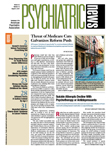Hawaii Gov. Linda Lingle (R) vetoed a bill in July that would have given psychologists in the state the authority to prescribe psychotropic medications. The state legislature, which passed the bill on May 1, has opted to forgo an override vote on the governor's veto.
Among the reasons for the veto that the governor cited in a letter to the legislature was that the bill (SB 1004) would not have required medical supervision of the psychologists authorized to prescribe medications. Other reasons for the veto, she said, were that it did not require psychologists to obtain “sufficient didactic and clinical training for prescriptive authority” and that it would allow psychologists to prescribe outside of Federally Qualified Health Centers (FQHCs)—a component of the bill that supporters claimed would have limited the prescriptive authority it granted.
The veto message echoed many of the concerns psychiatrists had raised about the limited level of training required by the prescribing program, specifically the lack of classes in cell biology and clinical pharmacology (Psychiatric News, June 1).
“APA applauds the leadership and continued efforts by patients, their families, and physicians in Hawaii to ensure that Hawaiians are not subjected to substandard and potentially dangerous care,” said APA President Carolyn Robinowitz, M.D., in a written statement issued after the veto was announced July 10. “APA strongly supports its state associations in their ongoing efforts to vigorously resist efforts to allow psychologists to practice medicine without the benefit of medical school and supervised medical residency.”
The governor cited opposition to the bill from both the Board of Medical Examiners and the Board of Psychology in her veto decision. The Board of Psychology did not want to take on the medical oversight role mandated in the bill. The Hawaii Psychiatric Medical Association, an APA district branch, coordinated a coalition of opponents to the bill, which included the AMA and several consumer groups. The American Society of Anesthesiology and American Academy of Ophthalmology joined APA in opposing the bill.
Jeffrey Akaka, M.D., a Hawaii psychiatrist and speaker of the APA Assembly, testified on numerous occasions that the proposed training would leave the psychologists unprepared to recognize and deal with the complex interactions of psychotropic medications.
One of the keys to stopping the prescribing bill, Akaka told Psychiatric News after the veto, was an educational effort directed at legislators that clarified the extensive biochemistry course work medical students undertake to understand the impact of medications on various types of patients.
Supporters of the psychologist-prescribing bill had claimed that it was modeled on the Department of Defense's Psychopharmacology Demonstration Project (PDP), which trained a small number of psychologists to prescribe in the 1990s. However, the governor concluded that the program the bill aimed to create “differs significantly” from the PDP. The proposed state program lacked the Pentagon program's specific requirements on the number of pharmacology classroom hours required and how many months of inpatient and outpatient care were needed to qualify for a “prescription certificate.”
Bill supporters “were trying to claim that the bill was as intensive as [the PDP], but the current bill bore no relation to that program,” Akaka said.
Another difference was that the PDP required close supervision by a psychiatrist with “advanced training in psychopharmacology,” while the rejected bill only would have required any physician to supervise psychologists for two hours each week.
The governor also criticized the proposed program because its practicum training would have taken place in small-scale FQHCs and not the comprehensive medical centers in which the PDP psychologists trained.
“The clinical experience settings are distinctly different, and the bill's practicum training is not comparable to that provided in the PDP model,” Lingle said in her veto message.
An expansion in the scope of practice for prescribing psychologists beyond what was allowed under the PDP also was cited as a reason for her veto. Psychotropic medication prescriptions by PDP psychologists were limited to patients aged 18 to 65 with “mental conditions” but without medical complications as evaluated by a supervising psychiatrist. The state program would have allowed participating psychologists to prescribe to patients of any age, including children, and those with medical problems comorbid with their mental illness.
Concerns about the unique challenges presented by psychotropic use in minors contributed to opposition to the bill from the American Academy of Child and Adolescent Psychiatry (AACAP).
“Psychologists are an important part of the treatment team, but do not have the years of training required to prescribe medication,” said Alfred Arensdorf, M.D., delegate to the Hawaii Council of Child and Adolescent Psychiatry.
Although proponents of the psychologist-prescribing bill have pushed for legislative enactment of such a program for more than 20 years, legislative leaders declined to hold a veto override vote on it during the legislature's one-day special session for such votes on July 10. A two-thirds majority in both chambers is required to override a veto.
The need for many more child and adolescent psychiatrists that bill supporters said prevents access to needed medications could be addressed through passage of the federal Child Health Care Crisis Relief Act, (S 1572, HR 2073) which would aim to increase the number of professionals providing comprehensive clinical mental health care to children and adolescents, according to AACAP.
Other federal action is needed, Akaka said, to lift burdensome restrictions on federal funding for psychiatrists in community health centers, which are readily allowed to fund allied health care workers, such as psychologists.
Akaka said Hawaii has made great progress in recent years to improve access to care for residents with serious mental illness, evidenced by the success of a small number of health centers to overcome the extra paperwork needed to procure federal funding for psychiatrists. Additionally, Hawaii has launched two telepsychiatry programs to provide care for residents in rural areas of the island chain.
The governor's veto letter to the legislature is posted at<www.hawaii.gov/gov/leg/2007-session/Folder.2007-04-13.1315/index_html> under SB 1004. ▪
